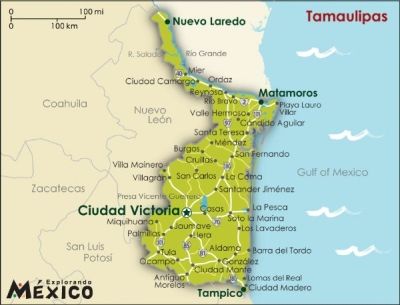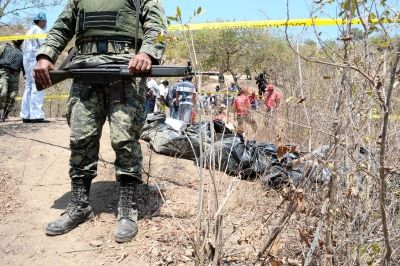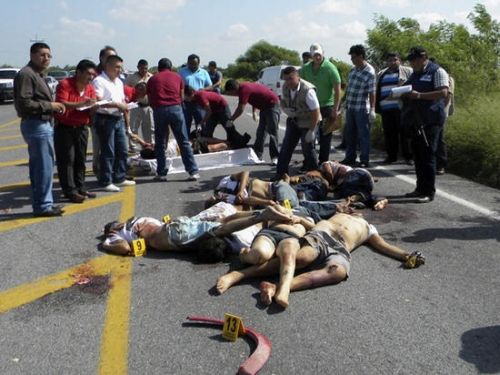
Publisher:
Bonnie King
CONTACT:
Newsroom@Salem-news.com
Advertising:
Adsales@Salem-news.com

~Truth~
~Justice~
~Peace~
TJP
Apr-21-2011 00:28

 TweetFollow @OregonNews
TweetFollow @OregonNews
The Demon Highways of Tamaulipas
Salem-News.comDespite a deluge of media coverage, the precise motives behind the mass killings are still unclear.
 Soldiers guard emergency morgue erected to house bodies from the mass graves discovered. Photo: AFP |
(TAMAULIPAS, Mexico) - In widely separated parts of Mexico, many people ask the same troubling question: Are our loved ones among the 145 dead found in the mass graves near San Fernando, Tamaulipas?
That’s been the question tearing at families in San Pedro Pochutla, a town in the southern state of Oaxaca. Last summer, ten townspeople set off on a long journey to the northern border state of Tamaulipas. None of them have been heard from since.
“Yes, they have to be returned safe and sound,” insisted Maria Vizarratea Salinas, San Pedro Pochutla resident and sister of three men missing in Tamaulipas. “We wouldn’t wish this situation even on our worst enemy. It is a desperate situation we are experiencing,” Vizarratea said.
In comments to the Mexican press, Vizarratea said the last possible clue anyone has of their loved ones' whereabouts comes from a phone call a sister made to her husband who was also part of the travel group. A strange man answered the spouse’s cell phone with the greeting “Federal Police.”
Thinking she had reached a wrong number, the sister dialed again only to get the same man on the line, according to Vizarratea.
 |
Relatives of the disappeared men from Oaxaca rejected the notion that their family members were involved in organized criminal activities, claiming that several of the men went to Matamoros, Tamaulipas, to purchase vehicles. Buying and selling used cars from the US has long been a popular business in Mexican border communities.
San Pedro Pochutla is not alone in its agony over the destinies of people who seemingly dropped off the face of the earth in Tamaulipas. A procession of 400 people recently filed into the saturated Matamoros morgue in search of disappeared family members. Besides locals, the anguished visitors included people from Oaxaca, Guerrero, Veracruz, Hidalgo, Mexico City, Zacatecas, Michoacan, and Jalisco.
Last month, relatives of missing persons staged a march in the Michoacan state capital of Morelia to press authorities for answers in the cases of 40 people reported disappeared in Tamaulipas and other states in 2010 alone.
In Guanajuato, meanwhile, relatives of eight men reported missing in Tamaulipas recently submitted DNA samples to the state attorney general’s office, in an effort to find out if their relatives were among the dead recovered from the San Fernando mass graves earlier this month.
Angeles Lopez, director of the Victoria Diez Human Rights Center, said the exposure of the Tamaulipas graves prompted more relatives of missing persons to come forward. Prior to the macabre discovery, 27 families had presented formal complaints of disappearance to Guanajuato state authorities. But after news of the graves broke in the media, the number of official complaints rose to 60, she added.
 |
Lopez said some of the cases were turned over to the United Nations Working Group on Enforced or Involuntary Disappearances, which released a preliminary report after conducting a two-week tour of Mexico in March.
According to the UN work group, more than 3,000 people were possible victims of involuntary disappearance in Mexico during the four-year period from 2006 to 2010, the spiraling years of death and disappearance in the so-called narco war.
The list of the missing far surpasses the number of people forcibly disappeared by government security forces during the dirty war against leftist guerrillas and political opponents from the late 1960s to the early 1980s, when somewhere between 600 to 1,200 people were abducted and never returned alive, according to estimates from former Fox administration investigators and Mexican non-governmental human rights organizations.
Added to these numbers are the hundreds and perhaps thousands of people who likewise vanished amid narco violence in various Mexican states- including Tamaulipas- in the years prior to 2006.
Notably, the San Fernando graves were publicly revealed only days after UN investigators wrapped up their well-publicized tour of Mexico. The remains of most of the presumed homicide victims have been transferred to the Mexico City medical examiner’s office for assistance in identification.
As of April 20, Mexican authorities had detained scores of people in connection with the burgeoning scandal, including 16 police officers suspected of aiding members of the Zetas criminal organization in committing and covering up mass murder.
Citing the Mexican navy and federal attorney general’s office, national press accounts named the alleged Zetas chief of San Fernando, Ramon Rincones, or “El Coyote,” as the ringleader of the murder squads. Rincones, who has not been apprehended, was likewise blamed for last year’s mass slaughter of 72 Central and South American migrants also near San Fernando.
Mexico’s National Human Rights Commission has identified 71 municipalities in Tamaulipas and 15 other states as constituting zones of high risk for migrants.
The Washington, D.C.-based Inter-American Commission on Human Rights (IACHR) urged the Mexican government to identify the latest San Fernando victims and get to the bottom of the murders, as well as adopt all the “necessary measures” to prevent the repetition of such horrors.
Further, the IACHR urged the Calderon administration to prosecute and punish “the perpetrators and masterminds” of the crimes, “whether this is a case involving organized crime or State agents in collusion with organized crime…”
 Twelve bodies found dumped along Tamaulipas, Mexico highway |
Despite a deluge of media coverage, the precise motives behind the mass killings are still unclear, though fleeting statements of alleged culprits combined with assorted media accounts sketch a pattern of the systematic targeting of both Mexican and foreign migrants and travelers in northern Tamaulipas, an area which has been ripped apart by a bloody conflict between crime syndicates since early 2010.
Though the Tamaulipas highways where many people have gone missing are checkered with government checkpoints, inter-city buses have become targets for mass kidnappings. Lately, the pattern of victims has grown from younger men to include women and girls, some of whom have been reportedly raped.
Months before the most recent kidnappings and mass graves scandal, the Tamaulipas grapevine warned of travel on state highways. “The least safe way to travel is by bus, which should be done by day,” cautioned a government social worker.
As if to underscore the ongoing threat, federal police officers in Reynosa, Tamaulipas, this week freed 68 persons, including 12 Central American nationals, who allegedly had been snatched from buses or even in the Reynosa bus terminal itself. Two young men were reported detained in connection with the case.
Some stories contend that migrants and travelers are forced to work for cartels or sold as prostitutes. In one case reported in Reynosa, two women were murdered after escaping from their captors and seeking out help from police and immigration authorities. Instead of arresting the criminals, the police purportedly turned the women back over to their kidnappers, who then killed the unlucky pair and left their bodies to rot as a warning to other captives.
Other accounts suggest mass killings were the fault of a psychotic, out-of-control Zeta dubbed “El Kilo,” and/or the bloody culmination of Mexican twists on the doctrines of “preemptive war” and counterinsurgency-inspired “population removal” in which men (and some women) of a certain age were eliminated if they refused to work for the underworld, or were just simply snuffed out before they happened to become hit men or employees of the rival Gulf Cartel.
Viewed in a broader context, Tamaulipas has long been a place bearing the socio-political characteristics of a large and contested feudal estate.
Back in the 1980s and preceding decades, much of the region was controlled by oil worker union chief Joaquin “La Quina” Hernandez Galicia.
The so-called “cacique,” or regional strongman, was deposed by then-President Carlos Salinas in one of his first, high-profile acts after taking office following a widely-suspected election fraud.
Crime syndicates, especially the Gulf Cartel, then filled the power vacuum. The period after 1988 would also herald the coming of the North American Free Trade Agreement, legal changes in the system of Mexican land ownership, the farm production crisis, climate disasters, spikes in Mexican and Central American migration to the US, and the arrival of peak oil combined with soaring energy demand.
Suddenly, Mexican petroleum exports acquired a much greater value than henceforth was the case, as did the passage of the commodities across the US border. All these storms and streams of people, trade and illicit products converged on the highways of Tamaulipas and were then funneled on their merry way to the money centers of the US heartland.
Sources:
- El Universal, April 20, 2011. Article by Alberto Morales.
- El Sur/Proceso, April 19, 2011.
- El Diario de Juarez/El Universal, April 18, 2011.
- Cimacnoticias, April 14, 2011. Article by Patricia Briseno.
- La Jornada, March 14, 21 and 28, 2011; April 19, 2011. Articles by Victor Ballinas, Francisca Meza, Pedro Miguel, Notimex, and editorial staff.
- Proceso/Apro, December 29, 2010; March 23, 2011: April 17, 18, 19, 20, 2011. Articles by Jose Gil Olmos, Hugo Vargas, Gloria Leticia Diaz, Jenaro Villamil, Miguel Cabildo, and editorial staff.
- Inter-American Commission on Human Rights, April 18, 2011. Press release.
- Mexican Naval Secretariat, April 17, 2011. Press release.
Frontera NorteSur: on-line, U.S.-Mexico border news
Center for Latin American and Border Studies
New Mexico State University
Las Cruces, New Mexico
Articles for April 20, 2011 | Articles for April 21, 2011 | Articles for April 22, 2011





Salem-News.com:
Terms of Service | Privacy Policy

All comments and messages are approved by people and self promotional links or unacceptable comments are denied.
spellchecker April 22, 2011 6:24 am (Pacific time)
Check the...
Editor Thank spellchecker!
[Return to Top]©2025 Salem-News.com. All opinions expressed in this article are those of the author and do not necessarily reflect those of Salem-News.com.